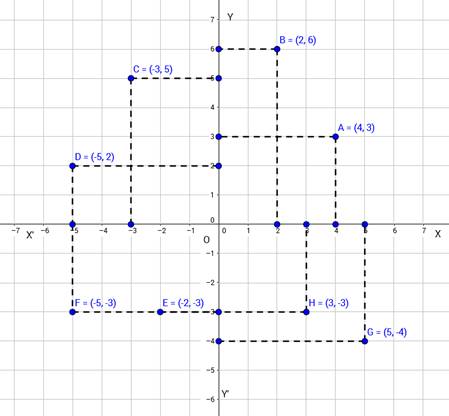On a graph paper draw the coordinate axes X’OX and YOY’, and plot each of the following points:
(i) ![]() (ii)
(ii) ![]()
(iii) ![]() (iv)
(iv) ![]()
(v) ![]() (vi)
(vi) ![]()
(vii) ![]() (viii)
(viii) ![]()
Let X'OX and YOY' be the coordinate axes.

(i) On the x−axis, take 4 units to the right of the y axis; and then on the y−axis, take 3 units above the x−axis. Thus, we obtain the point A(4,3)
(ii) On the x−axis, take 2 units to the right of the y−axis; and then on the y−axis, take 6 units above the x−axis. Thus, we obtain the point B(2,6)
(iii) On the x−axis, take 3 units to the left of the y−axis; and then on the y−axis, take 5 units above the x−axis. Thus, we obtain the point C(−3,5)
(iv) On the x−axis, take 5 units to the left of the y−axis; and then on the y−axis, take 2 units above the x−axis. Thus, we obtain the point D(−5,2)
(v) On the x−axis, take 2 units to the left of the y−axis; and then on the y−axis, take 3 units below the x−axis. Thus, we obtain the point E(−2,−3)
(vi) On the x−axis, take 5 units to the left of the y−axis; and then on the y−axis, take 3 units below the x−axis. Thus, we obtain the point F(−5,−3)
(vii) On the x−axis, take 5 units to the right of the y−axis; and then on the y−axis, take 4 units below the x−axis. Thus, we obtain the point G(5,−4)
(viii) On the x−axis, take 3 units to the right of the y−axis; and then on the y−axis, take 3 units below the x−axis. Thus, we obtain the point H(3,−3)